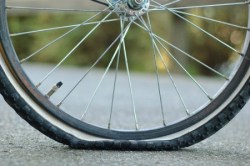Send your question to Umbra!
Q. Hello Umbra,
Through years of bicycle riding, I’ve never been able to pinpoint the exact reason why bicycle tires suck so badly. One fills a car tire with air maybe once or twice a year (really just checking the overall pressure), but a bike tire, it seems, has to be topped off over and over. Why are bike tires so lousy at their intended job of holding air under pressure?
John B.
Ann Arbor, Mich.

Photo by Shutterstock.
A. Dearest John,
Do you view topping off your tires as burden or pleasure? Because I will admit, I enjoy the ritual of checking the air pressure, marveling at how low it has gotten, assuming my best Groucho stance to operate the floor pump, wondering if I’ll expend all my strength before the ride has even begun, then taking off on nice taut tires. It makes me feel vaguely well prepared and vaguely mechanically inclined, two characteristics that are not among my foremost qualities.
But you’re right. Those of us who ride bicycles do an awful lot of pumping. And at a glance, it does seem that car tires just solidly do their job most of the time, while bicycle tires leak if you so much as look their way. That’s not quite true, though. Let’s look at the reasons why.
First of all, bike tires and car tires are built differently. Bike tires essentially have two parts: the outer shell and the inner tube — the ring that actually holds the air. The tube is made of a soft material, usually a synthetic rubber called butyl but sometimes latex. Because these materials are thin and permeable, they let air molecules wander out at will to check out their surroundings. And as we know, air has a funny way of not squeezing itself back in.
Your modern car tire, on the other hand, is big and fat and full of steel, and has no tube inside (although many bus, truck, and motorcycle tires do have tubes). Fascinating historical aside: Car tires were made of solid rubber until the late 1800s, when air-filled, or pneumatic, tires gained popularity. Most car tires then had inner tubes until the 1950s, when the more high-tech models we use today began to make their entrance. (You might want to read this oddly fascinating brief history, which includes Detroit’s fierce resistance to radials. I’ll wait.)
So bike tires are, in a sense, leakier by design. The other factor at play is the insane amount of pressure they face. Just look at the numbers: We fill a typical car tire to about 30 or 35 pounds per square inch (psi), depending on the specifications of our vehicle, while a typical road bike operates at about 90 or 100 psi. (Mountain bikes make do with a psi closer to that of a car, which is one reason their big, fat tires don’t need to be pumped up as often as road-bike tires.) In short, car tires hold a higher volume of air at lower pressure, while road-bike tires hold less air at higher pressure. The pressure is too much! The air in a road-bike tire is like James Dean in Rebel Without a Cause. It is restless and irritable and it just wants to escape.
You are not the only one wondering why bicyclists are saddled with this problem. In fact, various alternatives have emerged: tubeless tires, for instance, and self-healing tubes. The world of bike tires is a gearhead’s dream, actually, and not one I can do justice to here. But so far these alternatives are often expensive or clunky or both, which is why many of us stick to ye olde pumping ritual.
You don’t say how often you’re topping up, but it’s also possible that you have a slow leak. If you think this might be the case, you could take your tire apart and see if there are any obvious punctures, problems with the valve, or things inside that could be aggravating the tube. You can also put the inflated tube in water to see if any bubbles appear. If they do, it’s time for a patch or a replacement. Here is a handy and thorough guide from REI to finding the cause of a flat, dismantling a tire, replacing a tube, and other things all bike riders should know how to do.
One final note: You say you check and fill your car tires once or twice a year. Let me gently urge you to make it more like once a month. Underinflated car tires waste gas and money — you could save the equivalent of 11 cents a gallon just by rolling at the right psi. Of course, driving less would save you even more. You knew I had to say it.
Pneumatically,
Umbra



